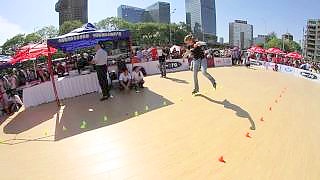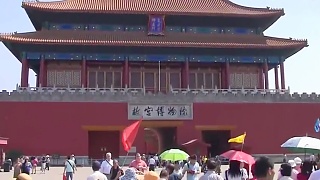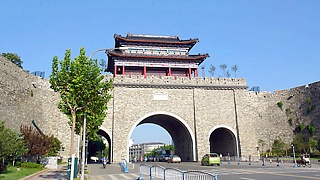Grand View Garden (DaGuanYuan) is a large imperial style garden; a recreation of the famous garden described in the classic Chinese novel "Dream of the Red Chamber" (also known as "A Dream of Red Mansions" or "The Story of the Stone"), written by Cao Xueqin during the Qing dynasty.
The construction of Grand View Garden began in 1984 and was completed in 1986. It covers an area of about 12 hectares (30 acres) and is designed to resemble the garden as described in the novel, with pavilions, corridors, artificial hills, ponds, and lush vegetation.
Visitors to Grand View Garden can explore various scenic spots and cultural attractions that are inspired by the characters and events from "Dream of the Red Chamber." Some of the highlights include:
Grand View Tower (Daguanyuanlou): This central pavilion serves as the main entrance to the garden and offers panoramic views of the surrounding landscape. It is a popular spot for visitors to take photos and admire the scenery.
Baochai Hall (Baochaifang): Named after one of the principal characters in the novel, Baochai Hall is a traditional Chinese-style building where visitors can learn about the life and culture of the Qing dynasty elite.
Jia Baoyu's Room (Jiabaojuyuan): This recreation of the protagonist's living quarters gives visitors a glimpse into the daily life of the fictional Jia family. The room is furnished with antique furniture and decorations reminiscent of the Qing dynasty.
Peach Blossom Island (Taoyuandong): Inspired by the idyllic setting described in the novel, Peach Blossom Island features winding paths, lush vegetation, and a tranquil pond surrounded by peach trees. It is a peaceful retreat within the garden where visitors can relax and enjoy nature.
The Eighteen Scenes of the Grand View Garden: These scenic spots are based on the poetic descriptions found in "Dream of the Red Chamber" and include attractions such as the Lotus Fragrance Pavilion, the Mountain of Toads, and the Three Wisdoms Hall.
In addition to its historical and cultural significance, Grand View Garden also hosts various cultural events, performances, and exhibitions throughout the year, including traditional Chinese opera performances, calligraphy demonstrations, and art exhibitions.
Overall, Grand View Garden offers visitors a unique opportunity to immerse themselves in the world of "Dream of the Red Chamber" and experience the beauty and elegance of traditional Chinese garden design. It is a popular destination for both tourists and locals alike, providing a tranquil escape from the bustling city of Beijing.
Beijing, the capital city of China, is a vibrant metropolis steeped in history, culture, and modernity. Here's a brief overview of what you can expect as a tourist in Beijing:
Historical Landmarks:
The Great Wall of China: One of the most iconic structures in the world, the Great Wall is easily accessible from Beijing. Mutianyu and Badaling sections are popular among tourists.
Forbidden City (Palace Museum): A UNESCO World Heritage Site, this vast imperial palace complex was home to Chinese emperors for over 500 years. It houses numerous halls, courtyards, and historical artifacts.
Temple of Heaven: A masterpiece of Chinese architecture, this ancient temple complex served as a place of worship for emperors to pray for good harvests.
Summer Palace: A stunning ensemble of lakes, gardens, and palaces, the Summer Palace served as a retreat for emperors during the Qing dynasty.
Tiananmen Square: One of the largest city squares in the world, Tiananmen Square is flanked by important landmarks such as the Monument to the People's Heroes, the Great Hall of the People, and the Mausoleum of Mao Zedong.
Cultural Sites:
Beijing Hutongs: Explore the narrow alleyways and traditional courtyard residences of Beijing's historic neighborhoods. You can take a rickshaw tour or simply wander around on foot.
Beijing Opera: Experience traditional Chinese opera performances at venues like the Liyuan Theater or the Chang'an Grand Theatre.
798 Art District: A hub of contemporary art and culture, this former industrial area is now home to numerous galleries, studios, and cafes.
Modern Attractions:
Olympic Park: Visit iconic structures such as the Bird's Nest (National Stadium) and the Water Cube (National Aquatics Center) from the 2008 Beijing Olympics.
CBD (Central Business District): Marvel at the futuristic skyline of Beijing's modern business district, which includes landmarks like the CCTV Headquarters and the China World Trade Center Tower III.
Culinary Delights:
Peking Duck: Indulge in Beijing's most famous dish, crispy roast duck served with pancakes, scallions, and hoisin sauce.
Street Food: Explore the city's vibrant street food scene and sample local delicacies like jianbing (savory crepes), lamb skewers, and dumplings.
Practical Tips:
Transportation: Beijing has an extensive public transportation system, including the subway, buses, and taxis. However, traffic can be heavy, so plan your travels accordingly.
Language: While English is not widely spoken, especially outside tourist areas, many signs and transportation announcements are in English. It's helpful to carry a translation app or a phrasebook.
Weather: Beijing experiences four distinct seasons, with hot summers and cold winters. The best times to visit are spring (April to June) and autumn (September to October) when the weather is mild and comfortable.
Etiquette: Respect local customs and traditions, such as removing your shoes before entering someone's home and using both hands to pass or receive items.
Beijing offers a rich tapestry of experiences for tourists, blending ancient heritage with modern innovations. Whether you're fascinated by history, culture, or culinary delights, there's something for everyone in this dynamic city.
 Grand View Garden, BeiJing
Grand View Garden, BeiJing












